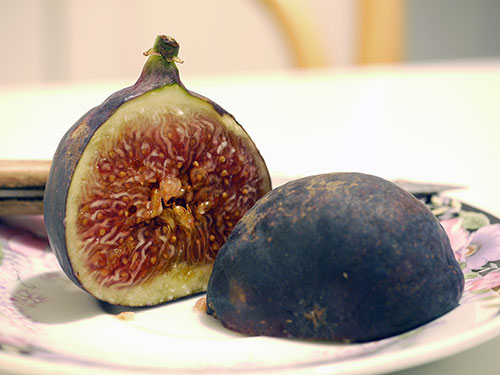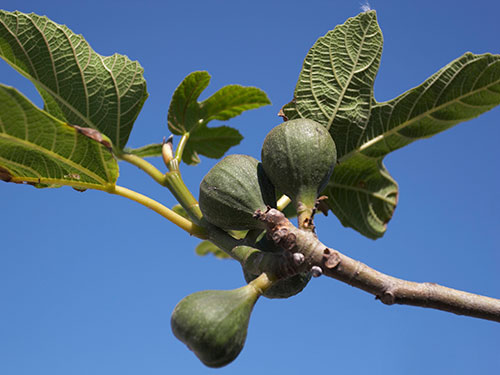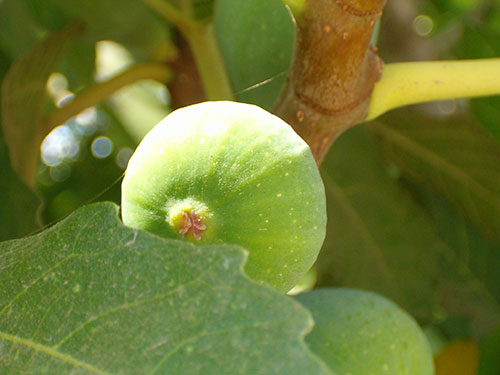
Fact Sheet FS1198
Many gardeners successfully grow figs (Ficus carica) in New Jersey for many years. However, since fig trees are evergreen plants in warmer climates, some type of low temperature protection is needed. Figs thrive in areas where winter temperatures do not drop below 15° F. Young trees can be damaged by early fall frosts when the temperature is 25-27° F. In New Jersey, fig trees will lose their leaves at this time and must be prepared for the dormant season's low temperatures to survive and flourish. One problem in New Jersey is that a fall frost often kills the second or late season figs before they fully mature. In the late winter, fig trees will begin their regrowth early and need continued protection until the temperatures moderate and danger of spring frosts has passed.
The fig is sometimes called a "fruit without a flower." It does have flowers, however, that are borne on the inside of the fruit. Most fig varieties yield two distinct crops of fruit each year. The first crop or what is called the breba crop is produced on the previous year's shoot growth; the second crop is borne in the leaf axils (where the leaf attaches to the stem) of the current season's growth. This breba crop is generally not as high in quality but the fruit are large and for some New Jersey gardeners may be the only crop if the growing season is shortened by early fall low-temperature injury.
There are four types of figs: Caprifigs, Smyrna, San Pedro and Common. In New Jersey, the first 3 types are not planted or suggested because of poor quality or difficulties in pollination of flowers, setting of fruit and fruit drop. Peculiarities of varieties of these types will not be discussed in this publication. The Common type figs are recommended. There are over 600 varieties of Common type figs that can set and mature one or two crops of figs without pollination. First crop (breba) are generally few in number, but larger in size than figs of the second crop. Only a few of these more common varieties are described.
The varieties listed on the following page do not require pollination to produce fruit. However, fruit set and yield will be influenced by the methods in which they are grown, the time of year when conditions are safe to bring them out of a protected environment or uncovered, and other factors. Therefore, some varieties listed as two crop varieties may not produce two crops each year. Genetically the Mission, Kadota, and Alma varieties can yield both first and second-crop figs. Other varieties, such as Brown Turkey and Adriatic, produce mainly second-crop figs. The amount of pruning can affect the quantity of the fruit, whether first- or second-crop figs. For example, severe pruning often practiced on Kadota figs, grown primarily for canning, drastically reduces the amount of the first crop. Pruning plants combined with low temperature exposure will greatly influence cropping.
| VARIETY | SKIN AND PULP COLOR | CROPS | SIZE | OTHER COMMENTS |
|---|---|---|---|---|
| Adriatic | Green with red to amber pulp | Two crops - First crop light | Medium | Good quality, used for drying |
| Alma | Greenish brown | Two crops | Small | Good |
| Brown Turkey | Light with large, purple figs. Second-crop figs, greenish to purple with pink pulp. |
Heavy producer | Large | Excellent tree ripened quality |
| Celeste | Brown to violet with pink pulp | One crop | Small pear-shaped with long stock | Widely grown in south. Good quality. |
| Green Ischia | Bright green | Medium | Good but with objectionable seeds | |
| Hardy Chicago | Darkish red to violet black with red pulp | Two crops | Quite tasty at full maturity | Did well in Chicago with its harsh winters but not as productive as varieties like Celeste |
| Kathleen's Black Fig | Dark violet to black with red pulp | Two crops | Slightly larger than Mission | Rich, sweet taste; May be the same Noire de Caromb |
| Marseilles | Green with white pulp | Two crops are similar | Medium size | Sometimes known as White Smyrna. Large prominent seeds |
| Mission | Both crops have purplish black with pink crop. | Two crops | Medium to large size | Reliable producer Excellent quality |
| Panache | Green and yellow striped fruit to yellow when mature with pink pulp | Two crops | Medium size | Good garden variety but only fair quality |
Even with protection varieties vary in their ability to withstand low temperatures which affects their level of fruitfulness. Mature trees of Brown Turkey, Celeste, and Hardy Chicago (if properly protected outside) will survive winters when temperatures drop to 0° F. Planting on a wind-sheltered site is desirable if soil and weather conditions are such that leaves are held into early winter. However, the wood of even the most cold resistant varieties may be killed back to the ground by early winter temperatures of 15° F.
Trees should be insulated to prevent winter kill. There are many ways to protect these trees from severe cold. Trees should be planted close to a house or a backyard wall to insulate them from drying winds as well as extremely cold temperatures. Wrapping the trees in burlap or tar paper can also provide protection. Another method is to build a 'cage' around the tree with chicken wire and then fill the space in the cage with either hay or composted mulch. Some gardeners will grow these varieties in large pots and when the chance of low temperatures occur, move them to an environmentally controlled structure like a green house, or if dormant into a cool indoor structure like a garage. When trees are in pots the roots can be killed if subjected to freezing temperatures.
Culture
Pruning
At the time of planting outside in the soil, cut off the tree to a height of 2 to 3 feet above the ground. During the first growing season, the new shoot growth that arises near the point of topping forms the structural or main branches. During the first dormant season, select three or four main branches that are evenly distributed around the trunk. Completely remove all other branches that arise from the trunk. Cut off the tips of the scaffold limbs about 3 feet from the trunk to encourage secondary branching, especially on varieties that tend to grow more vertically.
Continue to train fig trees during the first 5 years while the trees are increasing in height and spread. The main objective of pruning is to maintain tree growth in an upward and outward pattern by thinning out interfering branches and removing flat, low-growing limbs.
Prune mature trees during the dormant season by thinning branches and by slightly heading back long shoots to maintain tree vigor, shape, and balance. Remember, breba crop figs are produced at the ends of the previous year's shoot growth. If you desire first-crop figs, leave some full length branches when pruning.
Failure to prune a fig tree results in a bushy-type tree that lacks vigor, tends to be susceptible to limb sunburn, and produces small figs of inferior quality. Prune enough to stimulate at least 1 foot of new growth on most limbs each year.
If the trees need to be protected from winter cold, other cultural practices are recommended to ensure a crop of high-quality figs. Most growers cut back their fig trees before wrapping. This isn't necessary for plant health, but it's much easier to wrap figs that have been "skinned" and reduced in height down to about chest level. Because of this annual cutback, figs in the North typically grow only 8 to 12 feet tall. Over time, they end up wider than tall as the roots send out new shoots around the perimeter.
Irrigation
Since figs are subtropical in origin, they can tolerate drier soils than many fruit trees when established. Newly planted trees need to be watered or irrigated to establish the root systems.
Irrigate figs occasionally to obtain good crops. If trees are growing and producing satisfactorily in the lawn or garden, additional irrigation may not be needed. Fig trees like most fruit trees cannot be planted in poorly drained soils.
Soils and Fertilization
Fig trees grow in all types of well drained soil between a pH of 6-7.5. Before planting figs in the soil, a test kit should be purchased from the local county office of Rutgers Cooperative Extension to get a soil analysis of the pH and major soil elements. When the sample is submitted to the laboratory the labeling should indicate that it is for fig growing and a recommendation for fig fertilization will be made with the analysis.
Figs respond well to nitrogen fertilization. After the first season, apply fertilizer in early spring so it can work its way down to the roots. Using ammonium nitrate or ammonium sulfate, apply ½ cup of fertilizer in the first winter and increase the amount by ½ cup each year until trees are 4 years old. Make sure the fertilizer is spread evenly around the periphery of the tree and is 1 foot away from the trunk. Additional nitrogen applications can be made based on desired amount of growth. Organic forms of nitrogen can be substituted with the same growth considerations.
Be careful not to encourage excessive vegetative growth by nitrogen over-fertilization because this delays ripening and reduces fruit quality. If mature trees are producing more than 1 to 2 feet of new growth per year, reduce or eliminate nitrogen fertilizer.
Harvesting
Fig trees on their own root systems begin bearing fruit at 3 to 4 years of age. Depending on variety, the fruits ripen successively from around mid-September through frost. Fruits turn from green to purplish-brown when ripe and are shaped like mini-pears of 1 to 2 inches in diameter. For best quality the fruit should begin to soften while on the tree. Pickers may want to wear soft gloves to protect the fruit and to protect the picker from the milky liquid that exudes from the stem and twig scars. A fig usually requires a strong twisting action to loosen the fruit from the stem. Alternatively, pruning shears can be used to carefully cut the fruit from the branch. Figs must be handled carefully to avoid skin abrasions and fruit damage since some varieties may crack easily when fully ripe.
Propagation
Figs are typically grown on their own roots. They are propagated by taking dormant and semi dormant hardwood cuttings. To collect cutting from a fig tree the basal cut should be made just below a node. Cuttings can be taken from 1, 2 or 3-year-old wood about 9 inches long and pencil to no larger than ¾ inch in thickness. Cuttings should be from straight vigorous wood.
The cuttings are planted with the bases buried in the soil or other media, and with the very tops exposed to air temperature. They can be planted directly outside in soil with the tops protected or can be planted in a container of a good, well-drained soil medium. Cuttings, can be individually planted or in bundles of ten or less. They must be kept moist but well-drained and should root readily in a few months during the dormant season. Once they leaf out, separate them if in bundles, plant and water like any other plant that is actively growing. Protect young plants from low temperature injury.
Fig Problems
- Fruit Drop - Premature fruit drop can be caused by cool weather, insufficient irrigation, weak trees as a result of no pruning, or too much nitrogen fertilizer. Late-season figs that develop near the end of the branches, and late in the season, often dry up or drop because of insufficient heat needed to mature the fruit.
- Length of Growing Season - Remember that figs are subtropical; in New Jersey most fig varieties do not produce well due to the relatively short season. There is just not enough heat over the frost-free season to produce acceptable crops of high quality figs.
- Low Temperature Damage - To help trees overwinter they must be insulated. Wrapping the trees with either burlap or tar paper is recommended. An alternative is to 'cage' the trees with chicken wire and fill the cage with hay or leaf compost. Planting trees in the most protected areas around the backyard can also help to prevent winter kill.
- Insects - Fig trees and their fruit can be damaged by beetles, borers, mealy bugs, scale and stink bugs. Sanitation practices like removing susceptible plants of other species, high weeds, or severely damaged fig plants and leaves can help. Labeled insecticides can also be used.
- Disease - Fig Rust is a common fungus disease in the Southern United States. It infects newly developed and young leaves causing them to drop prematurely. Injured trees are more susceptible to low temperature injury. Control includes sanitation like removing infected leaves. Labeled fungicides are also available.
- Birds - Birds love figs. Follow accepted management practices for bird control like netting of trees or scare devices.
- Deer - Deer love the young leaves and shoots of fig trees. Follow accepted management practices like cages, fencing or other accepted management practices.
December 2012
Copyright © 2025 Rutgers, The State University of New Jersey. All rights reserved.
For more information: njaes.rutgers.edu.
Cooperating Agencies: Rutgers, The State University of New Jersey, U.S. Department of Agriculture, and Boards of County Commissioners. Rutgers Cooperative Extension, a unit of the Rutgers New Jersey Agricultural Experiment Station, is an equal opportunity program provider and employer.



